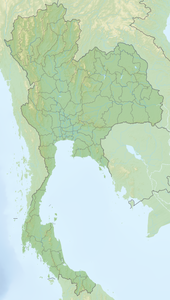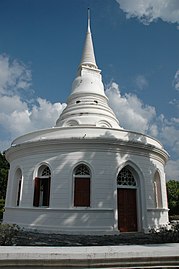Ko Sichang
| Ko Sichang | ||
|---|---|---|
| Ko Sichang as seen from the mainland | ||
| Waters | Gulf of Thailand | |
| Geographical location | 13 ° 9 '48 " N , 100 ° 48' 30" E | |
|
|
||
| length | 5.8 km | |
| width | 2 km | |
| Residents | approx. 5000 | |
Ko Sichang ( Thai : เกาะสีชัง ) is an island in the Gulf of Thailand in the eastern area of central Thailand . Ko Sichang is located in the west of Chonburi Province in the district ( Amphoe - Administrative District) Amphoe Ko Sichang , which mainly consists of the island ( Ko ) Sichang.
description
Ko Sichang is about 12 kilometers off the west coast of Amphoe Si Racha . It offers a rather peaceful atmosphere, which is also promoted by the fact that the road along the coast is only about one meter wide and is therefore only suitable for bicycles and motorbikes.
During the reign of King Chulalongkorn (Rama V), two Buddhist temples ( Wat ) were built on the island, Wat Tham Yai Prik (Thai: วัด ถ้ำ ยาย ปริก ) and Wat Atsadang Nimit (Thai: วัด อัษฎางค์ นิมิตร ). The latter is furnished with a chapel on the European model. On the island there is also a Chinese pavilion with dragon and peacock depictions as well as the Chakrapong cave , in which one can climb through a kind of chimney to the top of the hill.
On the opposite side of the island is Hinklom Beach (Thai: หาด หิน กลม ), the beach of round stones.
history
The kings Mongkut (Rama IV.) , Chulalongkorn (Rama V) and Vajiravudh (Rama VI.) Came to the island to relax here. King Chulalongkorn had a royal summer palace built. After his son was born on Ko Sichang, he named the palace Phra Chuthathut Palace ( พระ จุฑา ธุช ราชฐาน ). In 1900 the palace was professionally dismantled and rebuilt in Bangkok in the recently refurbished Dusit Palace , which is now behind the old parliament building (the Anantasamakhom throne hall ). There it is now called Wimanmek Palace (the heavenly palace) and is the largest teak building in the world. It houses 81 rooms, halls and anteroom on three floors and is furnished with memorabilia from the royal family from the end of the 19th century. The teak is covered with gold leaf in numerous places. The palace is visited daily by numerous tourist groups.
In the spacious park area of the palace on Ko Sichang there are still several buildings that served as accommodation for high officials and guests. There is also a small chedi on a hill, visible from afar, the construction of which was commissioned by Chulalongkorn in 1892. The chedi served as an ubosot and was often used by the king for meditation: the Phra Chedi of Wat Atsadang Nimit ( พระ เจดีย์ อุโบสถ วัด อัษฎางค์ นิมิตร ).
Web links
- Ko Sichang on amphoe.com (in Thai)



